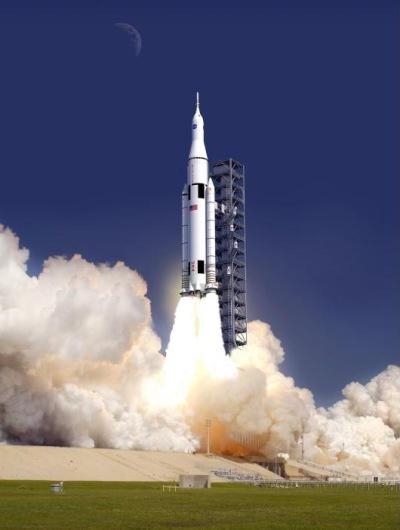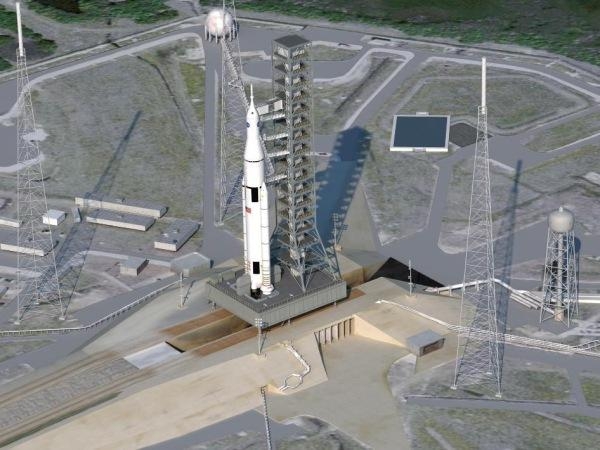You May Or May Not Know The Details About The Shuttle’s
Replacement Launch Vehicle
By Wes Oleszewski
On October 11, 2010 President Obama signed The NASA
Authorization Act of 2010. This placed into effect PL111-267 which
is the law that mandated that NASA must do specific things by
specific dates in order to bring to reality the government owned
launch system that is to be the next step beyond the shuttle. Of
course you cannot have any NASA launch system without an acronym
that becomes its moniker. In this case the Space Launch System has
been dubbed the “SLS.” Although, by law, NASA was
supposed to produce a complete plan for the SLS within 90 days of
the law’s signing, that release did not come until September
14, 2011- some 339 days after the law was signed.

Birth of the SLS came in the wake of the Obama
Administration’s FY2011 Budget Proposal. Within that proposal
was placed the proposal for NASA’s budget and with that
President Obama canceled the Constellation Program which was the
replacement for the Space Shuttle that NASA had already spent a
half dozen years and nearly $10 billion working to develop.
Additionally, the Obama plan had no defined objective for NASA and
no timetable to do anything other than wait for some undefined
“Path breaking” and “Game Changing”
technologies that were to come from someplace that was equally
undefined. It also took all of United States manned
spaceflight efforts and simply turned them over to a select few
private, start-up companies that were selected for reasons
unexplained. That portion of the overall FY2011 Budget Proposal
sent shock waves through the aerospace community, through NASA,
through NASA contractors and through the Congress where, by the
way, Constellation had wide support on both sides of the aisle.
This, however, meant nothing to the Obama Administration which had
other ideas about NASA. Simply put, they sought to completely gut
the Federal human spaceflight program and rebuild NASA as an
academic think-tank in one swift stroke. Although that may have
worked for Hugo down in Venezuela, it did not go over at all for
Barak in the United States.

Within months of the Obama FY2011 budget proposal, the Congress
had negated the administration’s “new” direction
for NASA and composed a new space act which President Obama signed
into law. In that law the Congress directed NASA to come up with a
launch vehicle that could loft 70 tons and later evolve into a
vehicle that could loft 130 tons. In an effort to preserve the
maximum amount of talent and skill in the spaceflight work force,
the law-makers specified that work on the new launch vehicle must
begin with a detailed design plan from NASA due 90 days after the
law was signed and then press to begin physical construction
immediately thereafter. The new vehicle was also to make the
maximum use of Shuttle and Constellation hardware and facilities to
the greatest extent possible in order to preserve the workforce.
Under the influence of the White House, NASA finally delivered the
SLS plan 249 days behind that imposed schedule.

Now that NASA’s politically appointed administrators have
finally release to the public the details of the new vehicle, we
can take a good look at the new launcher. Of course, the
spaceflight community has known since 2010 what the SLS
configuration will likely be. In fact the basic arrangement has
been discussed by NASA engineers for several years. The basic
arrangement uses a Space Shuttle external tank as the
“core” of the vehicle with two Shuttle derived SRBs
attached in a manner similar to that of the Shuttle itself. The
difference being that the SRBs each have five segments instead of
the four segments used on the Shuttle. Additionally, the core tank
has a thrust structure built onto its base and attached there will
be either three or five Space Shuttle Main Engines (SSME). Atop the
tank will be placed a second stage that will be powered by a J-2X
engine derived from the Saturn rockets that were used in the Apollo
program. That stage will be used for boosting cargo or for boosting
the Orion Multi Purpose Crew Vehicle (MPCV) into missions beyond
Earth Orbit (BEO). In early test flights that second stage may be
substituted with a Delta IV “kicker” upper stage that
can be used to boost the Orion. This overall configuration allows
for the launching of crews and the safety of a Launch Abort System
(LAS), or escape tower, to cover all phases of boost.
In operation the SLS will lift off by first igniting the SSMEs,
followed several seconds later by the SRBs in a manner similar to
the Shuttle. The primary difference will be that the five SSMEs
will develop a combined thrust of ~2 million pounds while the five
segment SRBs will each develop ~3.6 million pounds of thrust giving
the vehicle a total thrust at liftoff of ~9.2 million pounds. That
is 1.5 million pounds more thrust than the Saturn V moon
rocket’s maximum liftoff thrust of 7.7 million pounds and
just a bit short of the Soviet N1 rocket which reportedly produced
~10 million pounds of thrust. That will, however, make the SLS the
most powerful rocket ever launched by the United States.
At staging the two SRBs will drop away as they have done with
the Space Shuttle, however, these new five segment SRBs will have
burned significantly longer than the Shuttle SRBs and will stage at
a far higher altitude. The decision as to if or not the new SRBs
will be recovered for reuse has still not been announced by
NASA.

After SRB jettison, the core stage will continue to fire to near
orbital velocity. At the end of its burn it and its formerly
reusable SSMEs will burn up on reentry. In case you are wondering
why they are throwing away the “reusable” SSME’s,
there is a good reason. It was found that the “cost savings
of reusability” attached to the SSMEs turned out to be a
myth. Each and every time that an SSME was returned from a Shuttle
flight, it was removed from the orbiter, disassembled, inspected,
reassembled and reinstalled into the orbiter. The overhead cost it
doing that turned out to be more than the cost of building a new,
disposable version of the same engine. Although this inspection
standard was required to maintain the high degree of safety
involved in the Space Shuttle program, it more than negated any
cost savings in the concept of “reusability.” Thus, the
early SLS vehicles will use up the stock of reusable SSMEs (also
known as RS-25D engines) and then transition into a semi-new and
disposable version of the SSME, (the RS-25E) all of which will
discarded in the launch process. In doing so the SLS program can
actually operate with less overhead than the Shuttle.
Ground Support Equipment (GSE) for the SLS will make use of
hardware left over from the Constellation program that was canceled
by the Obama Administration, as well as facilities from the Shuttle
program that was ended by the Bush Administration, plus facilities
and equipment left over from the Apollo program that was canceled
by the Nixon administration with the help of the Johnson
administration. Thus, the facilities of Launch Complex 39 plus the
VAB and Launch Control Center will all be pressed into service.

One of the Constellation contracts that was able to be completed
before the Obama administration decided we did not need to go to
the moon again because, as the President so snidely put it
“Buzz (Aldrin) has already been there” was a mobile
launcher. This launch platform and umbilical tower also known as an
LUT is similar to those that rolled to the pad with the Saturn V.
The difference, however, is that this LUT is made to be ultra light
weight. The Apollo LUTs were constructed of steel “I”
beams and built without weight considerations being a major
limiting factor. This could be done because the Saturn V itself,
when rolled to the pad, un-fueled, on its LUT weighed just over
502,000 pounds. The LUT itself weighed in at 10.6 million pounds.
The result was that the crawler was designed to carry over 17
million pounds of load, including its own weight. A fully stacked
Constellation heavy launch vehicle would weigh nearly five times
more than the un-fueled Saturn V because the twin SRBs are always
“loaded” and each weighs more than 1.4 million pounds.
Thus, a new lightweight LUT had to be designed and constructed.
Intended for the Ares I, that LUT was fully erected when President
Obama canceled Constellation. Some in the media referred to it as
“That big waste of money” but the fact is that the LUT
is simply a skeleton and has no vehicle specific workings
installed- thus it can be adapted to another vehicle. Enter the SLS
and what will be a new use for the Constellation LUT- that is, if
the ATK proposed Liberty launch vehicle does not get to it
first.
So, at this moment in time the SLS is ready and able to move
ahead. And after having signed into law a launch system that he
does not want, President Obama has used every tactic his
administration can imagine to delay and block the actual production
of the SLS vehicle and the implementation of the law that created
it. The President’s Office of Management and Budget (OMB) has
refused to request funds for the vehicle, NASA’s politically
appointed administrators have foot-dragged reports and plans
required by the Congress while OMB required a protracted
“independent” survey of the costs involved. When that
survey did not show the inflated costs that the administration
wanted to see, the report was tossed into a tar pit of the NASA
Administrator’s office. Finally, information was
“leaked” to the Wall Street Journal and the Orlando
Sentinel stating that the SLS was found to cost about twice as much
as planned and the White House had “sticker shock.” For
Senators Kay Bailey Hutchison and Bill Nelson, that was the last
straw. They finally marched into the offices where the delay
tactics were originating and applied the needed pressure to get the
program made public and get the SLS moving. Exactly what the
pressure was and where it was applied is unknown, but the fact is
that on September 14, 2011 the United States Congress may have
rescued NASA’s human spaceflight program from strangulation
by the Obama administration.
 ANN's Daily Aero-Linx (04.15.24)
ANN's Daily Aero-Linx (04.15.24) Classic Aero-TV: 'No Other Options' -- The Israeli Air Force's Danny Shapira
Classic Aero-TV: 'No Other Options' -- The Israeli Air Force's Danny Shapira Aero-News: Quote of the Day (04.15.24)
Aero-News: Quote of the Day (04.15.24) Airborne 04.16.24: RV Update, Affordable Flying Expo, Diamond Lil
Airborne 04.16.24: RV Update, Affordable Flying Expo, Diamond Lil ANN's Daily Aero-Term (04.16.24): Chart Supplement US
ANN's Daily Aero-Term (04.16.24): Chart Supplement US







